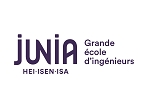Establishment
Language of instruction
English, French
Teaching content
MB-IT
Training officer(s)
F.WINDAL, D.DELANNOY
Stakeholder(s)
H.BENHABILES, Equipe Informatique de Crédit Agricole
Présentation
Prerequisite
• Java Courses (M1, semester 1)
• Network & Sys base (M1, semester 1)
• Data bases (CSI3, CIR3, semester 2)
• Network & Sys base (M1, semester 1)
• Data bases (CSI3, CIR3, semester 2)
Goal
Compétences visées : 34(342,343), 41(412, 413,414), 42(422), 53(531,532), 54(541,542), 61(611,612,613), 62(621,622), 63(632,634)
Cloud Computing
The objective of this part of the course is to introduce the fundamental concepts of Google Cloud for a company.
This platform includes various cloud services for computing, storage, networking, Big Data, machine learning, Internet of things, security, cloud management and application development that are directly launched on Google's servers.
Architecture :
The objective of this part of the course is to understand the concept behind the term "Big data", from a perspective:
- Architectural: resource organization, servers for performance optimization
- Technological: the software suite deployed
- Business: understanding the client's needs for the implementation of decision support tools
Cloud Computing
The objective of this part of the course is to introduce the fundamental concepts of Google Cloud for a company.
This platform includes various cloud services for computing, storage, networking, Big Data, machine learning, Internet of things, security, cloud management and application development that are directly launched on Google's servers.
Architecture :
The objective of this part of the course is to understand the concept behind the term "Big data", from a perspective:
- Architectural: resource organization, servers for performance optimization
- Technological: the software suite deployed
- Business: understanding the client's needs for the implementation of decision support tools
Presentation
Cloud Computing
• Introduction of the fundamental concepts of cloud computing, technical aspects (data center architecture, non-relational databases) and economic aspects (service and billing)
• Development & deployment of a web application on the Goolge Cloud platform - PaaS service
Big data Architecture :
Part 1: Deploying a Big Data Architecture
1. Understand the notions of performance in the deployment of a Big Data architecture,
2. Acquire knowledge about data storage solutions.
3. Discern the differences between databases (NoSQL, Elastic, Oracle, MongoDB...)
4. Understand the importance of file systems (HDFS) in a Big Data architecture
5. Example of the implementation of the "Crédit Agricole" datalake
Part 2: The Framwork Spark.
1. Understand fast distributed computing on large volumes with Spark.
2. Implementation of the Spark toolbox, allowing streaming, machine learning and graph processing
3. Introduction to the Scala language
4. Enter the fault tolerance mechanisms in case of data loss.
• Introduction of the fundamental concepts of cloud computing, technical aspects (data center architecture, non-relational databases) and economic aspects (service and billing)
• Development & deployment of a web application on the Goolge Cloud platform - PaaS service
Big data Architecture :
Part 1: Deploying a Big Data Architecture
1. Understand the notions of performance in the deployment of a Big Data architecture,
2. Acquire knowledge about data storage solutions.
3. Discern the differences between databases (NoSQL, Elastic, Oracle, MongoDB...)
4. Understand the importance of file systems (HDFS) in a Big Data architecture
5. Example of the implementation of the "Crédit Agricole" datalake
Part 2: The Framwork Spark.
1. Understand fast distributed computing on large volumes with Spark.
2. Implementation of the Spark toolbox, allowing streaming, machine learning and graph processing
3. Introduction to the Scala language
4. Enter the fault tolerance mechanisms in case of data loss.
Modalités
Organization
| Type | Amount of time | Comment | |
|---|---|---|---|
| Face to face | |||
| Lectures - face to face | 14,00 | ||
| Lab | 14,00 | ||
| Independent study | |||
| Independent study | 30,00 | ||
| Overall student workload | 58,00 | ||
Evaluation
| Control type | Duration | Amount | Weighting |
|---|---|---|---|
| Continuous assessment | |||
| Test (Quizz) | 2,00 | 2 | 50,00 |
| Others | |||
| Mini-project | 2,00 | 1 | 50,00 |
| TOTAL | 100,00 | ||






